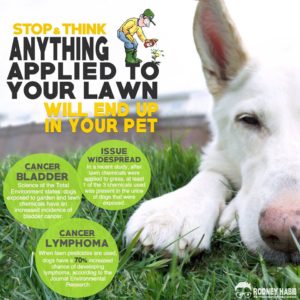
Study Finds Herbicides in the Urine of Pets After Home Lawn Chemical Treatment
“Considerable interest has been generated by a recently published study by PCOP scientists and key collaborators at Purdue University and the University of North Carolina.
The purpose of the study was to determine the extent to which lawn chemicals are taken into the body of dogs and eliminated in the urine.
This study was in follow-up to an earlier study that showed a significant association between lawn chemical exposure and increased bladder cancer risk in dogs.
Some of the important findings and conclusions are summarized below:
• Lawn chemical exposure was widespread in dogs. At least 1 of the 3 chemicals measured in the study was present in the urine of dogs in the majority of the 25 households after lawn chemicals were applied to the grass.
• ‘Untreated’ grass also contained lawn chemicals, presumably from drift from nearby treated areas. At least 1 of the 3 chemicals was detected on the grass in 7 of 8 control households, as well as in many of the “treated” households BEFORE the chemicals were applied.
• Half of the dogs living in ‘untreated’ control households had lawn chemicals in their urine.
• The condition of the grass affected how long the chemicals persisted on the surface of the grass where they would be taken up by dogs. Chemicals persist longer on dry brown grass. Chemicals were detected on the grass at 48 hours after treatment in the household study.” – Purdue University
What’s Even Worse:
“Once contaminated, dogs can pass the chemicals on to their owners and to others in the household. The study only looked at dogs, but the researchers suspect that cats and other pets could also be affected.
‘Dogs can pick up the chemicals on their paws and their fur,’ Deborah Knapp, lead author of Purdue University’s Department of Veterinary Clinical Sciences, explains. ‘They can then track the chemicals inside the house, leaving chemicals on the floor or furniture. In addition, if the dog has chemicals on its fur, the pet owner could come in contact with the chemicals when they pet or hold the dog.’
John Reif, a professor emeritus of epidemiology at the Colorado School of Public Health, told Discovery News, ‘The paper presents important information since exposure to 2,-4-D, a widely used broad leaf herbicide, has been associated with increased risk of cancer in pet dogs and humans.’” – Discovery News
This means that we, the humans, are unknowingly exposing our pets to cancer and they, our pets, are unknowingly returning the favor as they bring the toxins back into our households.
The bottom line is pets can absorb lawn chemicals from exposure to their treated lawn, exposure to their untreated but contaminated lawn, and from other treated areas such as parks.
Researchers suggest that if owners still must use herbicides, they should follow manufacturer guidelines, allow gardens and lawns to dry before allowing pets out, wash their dog’s feet each time the dog comes inside, and consider treating the back yard one week before the front (or vice versa) so that pets will have an area of less potential chemical exposure available to them.
For more info and lawn maintenance ideas, click here – http://ow.ly/4n2prU
“An educated, informed and well-researched community of pet owners can only put more pressure on the pet food industry to be better! When pet owners know better, they will only do better!”
Reprinted from Planet Paws on Facebook. Blog by Rodney Habib, Pet Nutritionist Blogger.








